| Article ID | Journal | Published Year | Pages | File Type |
|---|---|---|---|---|
| 8482469 | Journal of Equine Veterinary Science | 2018 | 41 Pages |
Abstract
The aims of the study were to determine whether adipose tissue global gene expression (1) differs between never laminitic (NL) and previously laminitic (PL) ponies, (2) is influenced by season and/or a diet designed to simulate spring grass, and (3) differences seen also occur systemically in peripheral blood mononuclear cells (PBMCs). Subcutaneous adipose tissue and PBMCs were obtained from six NL and six PL ponies on three occasions; summer, winter (season study), and in winter after consuming a diet simulating spring grass for 7 days (diet study). Adipose tissue global gene expression was determined using a 44K equine-specific microarray, validated using multiplex quantitative real time polymerase chain reaction (qRT-PCR), and analyzed using GeneSpring software and Ingenuity Pathway Analysis. PBMC gene expression was quantified using qRT-PCR. The total number of genes whose expression differed (â¥2-fold change, P ⤠.01) between PL and NL ponies was greater in summer (192 genes) compared to winter (58 genes); 40/192 genes influenced by disease in the summer were also seasonally regulated and were predominantly associated with inflammation. The genes modified by dietary intervention and PBMC gene expression did not follow the same pattern as the season study. Thus, adipose tissue global gene expression differed between NL and PL ponies most in summer compared to winter, and these differentially expressed genes predominantly related to inflammation.
Related Topics
Life Sciences
Agricultural and Biological Sciences
Animal Science and Zoology
Authors
Amy J. Timpson, Amanda M. de Mestre, Jonathan Elliott, Patricia A. Harris, Zhangrui Cheng, Samantha M. Mirczuk, Lindsay Callan, Lucille Rainbow, Nicola J. Menzies-Gow,
